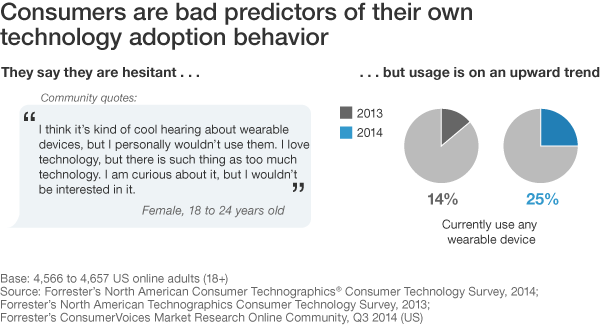The Data Digest: The Counterintuitive Consumer
Forrester has been analyzing device adoption since the launch of its Consumer Technographics® studies in 1997. Over the years, it has become evident that although demographics and attitudes influence technology adoption, these elements alone do not predict consumer behavior – subtle factors like context and psychological needs must be taken into account to piece together the technology adoption prediction puzzle. This is because of two essential contradictions that exist between:
- What consumers say they will do and what they actually do: The concept of introspection illusion reveals the discrepancy between stated intent and subsequent behavior. Consumers are bad predictors of their own technology adoption patterns and are often conservative when estimating their own device usage.
- What consumers say they want and what they really want: As Steve Jobs famously put it, “People don’t know what they want until you show it to them.” And even then, consumers might not recognize the benefits of the product – needs are transient, circumstantial, and often conflicting.
Take wearable technology as a (timely!) example. A blend of Forrester's Consumer Technographics quantitative and qualitative data shows that while interest in wearable devices is growing remarkably, consumers say they are hesitant to use the technology. However, as consumers begin to experience the comfort and connection these gadgets provide, adoption numbers trend up:

Consumer behavior can be counterintuitive: Stated intentions are not sufficient to understand technology adoption. Ultimately, to predict device usage, insights professionals must evaluate the contradictions in consumer behavior and psychology by integrating “hard” and “soft” data. In my recent research report, I explore the solutions and implications of this approach further.
In a world where the pace of innovation is accelerating exponentially and where consumers’ acceptance of new technology is quicker and increasingly contextual, the need to predict how and why consumers adopt technology is more challenging – and more important – than ever.
